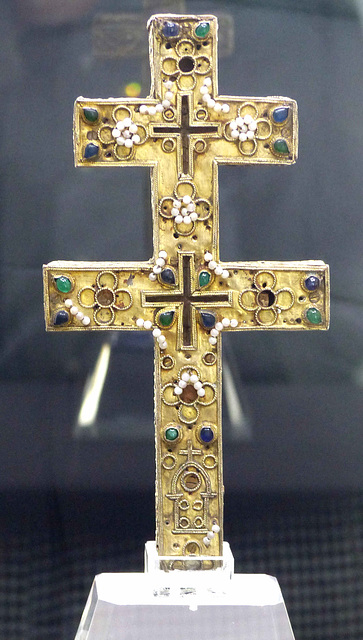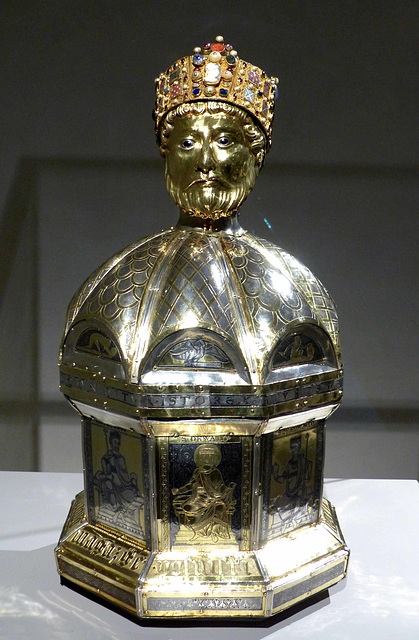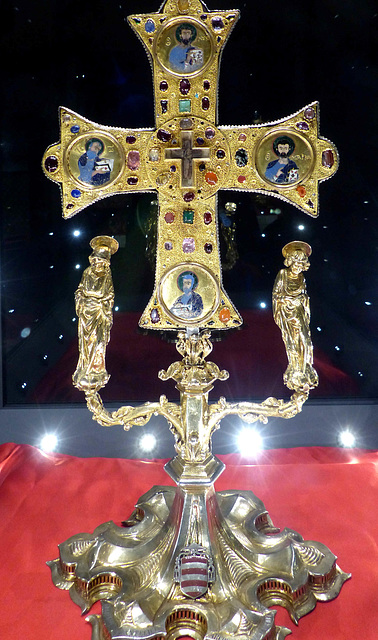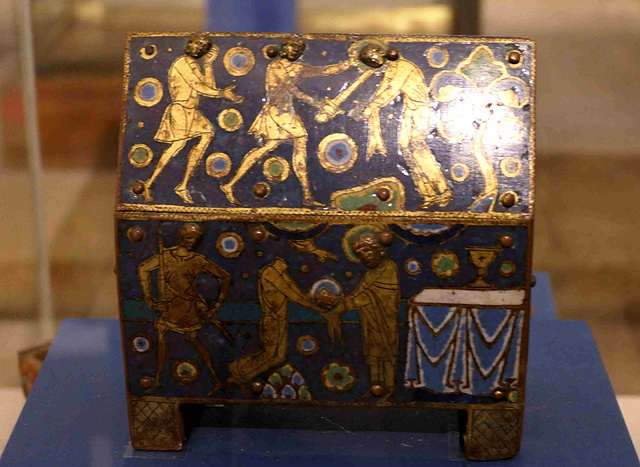
Medieval Goldsmithery
Agen - Musée des Beaux-Arts
The Gallo-Roman city of Aginnum, which existed here, was very populated and had an amphitheater that could accommodate more than 10,000 people. From the end of the 3rd century , the chronicles relate the martyrdoms of Saint Caprais and Saint Foy, who are said to be buried in Aginnum. The first known bishop, named Phébade, is documented a century later.
Over the following centuries, Agen was invaded by the Vandals, the Visigoths, and the Franks before being attacked by the Vikings in the 9th century. Historians have noted three invasions: in 843, 853, and the last in 922. A great loss for Agen was when at the end of the 9th century monks from Conques could steal the relics of St. Foy and transfer them to Conques (where they still are).
In the 13th and 14th centuries, the city was contested between the English and the French. In the early stages of the Hundred Years' War, it came to the English but was conquered and recaptured twice. In 1372, the Duke of Anjou established his headquarters here. Although he lost the city the next year, he was able to retake it by 1374. While thereafter part of the towns and castles of Agenais were temporarily under English rule, Agen remained almost permanently in French hands until the end of the war.
The Musée des Beaux-Arts is lodged in four magnificent Renaissance mansion houses which open out on to fine inner courtyards.
The "Tresor de Castillones" consists of 10 pieces of medieval goldsmithery. It was discovered in Castillones, a fortified town, before 1907.
This cross is one of the pieces found.
Hildesheim - Dommuseum
Louis the Pious founded the bishopric of Hildesheim in 815. The settlement developed into a town and was granted market rights by King Otto III in 983. Craftsmen and merchants were attracted and the city developed into an important community. By 1167, Hildesheim was an almost completely walled market settlement.
At the beginning of the 13th century, Hildesheim had about 5,000 inhabitants, and when Hildesheim received its city charter in 1249, it was one of the largest cities in northern Germany. The clergy ruled Hildesheim for four centuries before a town hall was built and the citizens gained influence and independence. In 1367, Hildesheim became a member of the Hanseatic League. But what is now called Hildesheim was various small "suburbs". After centuries of (sometimes armed) disputes, it was not until the end of the 16th century that a union was created and subsequently at least the inner wall was taken down Old and New Town.
During the Thirty Years' War, Hildesheim was besieged and occupied several times. In 1813, after the Napoleonic Wars, the town became part of the Kingdom of Hanover, which was annexed by the Kingdom of Prussia as a province after the Austro-Prussian War in 1866.
The air raids on Hildesheim in 1944/45 destroyed large parts of the city. Of the 1500 half-timbered houses, only 200 remained. 90 percent of the historic old town was destroyed in the firestorm.
-
Bishop Gunthar, who was in office in Hildesheim from 815 to 834 had a small basilica built. This served as the original cathedral. The next cathedral was built by Bishop Altfried in 872 as a cruciform three-aisled basilica with a two-story westwork. The building suffered severe fire damage in 1046. Bishop Hezilo built then incorporated the surviving walls into the new building using the foundation of the former basilica. Until the 14th century, further profound changes took place, but without deviating from the ground plan of the basilica. The side chapels date from the Gothic period. From 1840 to 1850, the original west building, which had fallen into disrepair, was replaced by a neo-Romanesque double tower front, which remained in place until 1945.
During the air raids on Hildesheim in WWII, the cathedral was completely destroyed except for the west building, the southern nave arcades, and the outer walls. Only the crypt and the Laurentius Chapel from the 11th century were preserved.
The cathedral was rebuilt in a simplified form between 1950 and 1960. The baroque elements were abandoned in favor of a form that took its cue from the early Romanesque style.
-
The "Dommuseum" is the "Schatzkammer" (treasury) of the cathedral. It is located in historic rooms off the southern transept of the Cathedral, the church of St Antonius and part of the cathedral cloisters.
The so-called "Hezilokreuz" (Hezilo Cross), was created before 1079.
In the center is a small raised plate on which sit eight stones in filigree settings; the middle one, probably a large crystal above the cross particle, is missing, and has been replaced by a graceful Gothic door with a bishop's image
Gerace - Duomo di Gerace
The history of Gerace is closely linked to that of Locri at the coast, as the inhabitants abandoned Locri and fled from a Saracen attack and piratical dangers. They settled inland, where is Gerace now.
The Locrian diocese was moved to Gerace and the innumerable presence of churches and monasteries helped to identify the fortress as a kind of Holy Mount. Because of its particular position, however, Gerace soon became a center of exceptional importance. The possibility of controlling coastal traffic, and the natural fortification, meant that it became the object of attention of the Byzantine Empire and the Kingdom of Sicily. In 986 the Saracens briefly conquered the city, but it returned to Byzantine control until the Norman conquest in 1059. Gerace was the seat of a principality under the Normans.
The "basilica concattedrale di Santa Maria Assunta di Gerace" is one of the largest sacred buildings in the region. The construction was started in the Norman period, with a projecting transept that reflects the Norman customs. The church was consecrated for worship in 1045. In the Swabian period, in 1222, a second consecration took place.
The building was hit by several earthquakes over the centuries, which led to a number of significant changes.
The interior of the basilical church has three large naves, which make up the longest arm of a Latin cross. They are separated by two rows of ten columns, made of polychrome marble and granite, all varying in quality and size. The columns come from the villas of the marina of ancient Pagliopoli/Locri, while the capitals are partly ancient and partly remade.
In the crypt there is a small museum.
This reliquary cross was made in the 12th century by a Jerusalemite workshop. It is a "stauroteka" as it contains a splinter of the "True Cross".
Auxerre - Cathédrale Saint-Étienne
The Cathédrale Saint-Étienne seen today is actually the 5th on the spot.
The erection started in 1215 around the same time, when the building of the cathedrals in Reims and Amiens started. The choir was completed in 1235. The stained glass of the choir windows was created until 1250. The same time, the construction of the facade began. Around 1300, construction began on the southern arm of the transept.
The sculptured portal is dated to around 1320. The nave was built from around 1320–1350, but the Hundred Years' War slowed the work down and delayed the completion of the south aisle until 1378. The north transept and the towers had not begun at the beginning of the 15th century. In 1478, the nave was vaulted and in 1500 work on the north tower began and was completed after 43 years. The south tower was never completed.
Though looted a couple of times, the cathedral has precious works of art in the treasury. Here are displayed three reliquaries from the 13th century.
Hildesheim - Dommuseum
Louis the Pious founded the bishopric of Hildesheim in 815. The settlement developed into a town and was granted market rights by King Otto III in 983. Craftsmen and merchants were attracted and the city developed into an important community. By 1167, Hildesheim was an almost completely walled market settlement.
At the beginning of the 13th century, Hildesheim had about 5,000 inhabitants, and when Hildesheim received its city charter in 1249, it was one of the largest cities in northern Germany. The clergy ruled Hildesheim for four centuries before a town hall was built and the citizens gained influence and independence. In 1367, Hildesheim became a member of the Hanseatic League. But what is now called Hildesheim was various small "suburbs". After centuries of (sometimes armed) disputes, it was not until the end of the 16th century that a union was created and subsequently at least the inner wall was taken down Old and New Town.
During the Thirty Years' War, Hildesheim was besieged and occupied several times. In 1813, after the Napoleonic Wars, the town became part of the Kingdom of Hanover, which was annexed by the Kingdom of Prussia as a province after the Austro-Prussian War in 1866.
The air raids on Hildesheim in 1944/45 destroyed large parts of the city. Of the 1500 half-timbered houses, only 200 remained. 90 percent of the historic old town was destroyed in the firestorm.
-
Bishop Gunthar, who was in office in Hildesheim from 815 to 834 had a small basilica built. This served as the original cathedral. The next cathedral was built by Bishop Altfried in 872 as a cruciform three-aisled basilica with a two-story westwork. The building suffered severe fire damage in 1046. Bishop Hezilo built then incorporated the surviving walls into the new building using the foundation of the former basilica. Until the 14th century, further profound changes took place, but without deviating from the ground plan of the basilica. The side chapels date from the Gothic period. From 1840 to 1850, the original west building, which had fallen into disrepair, was replaced by a neo-Romanesque double tower front, which remained in place until 1945.
During the air raids on Hildesheim in WWII, the cathedral was completely destroyed except for the west building, the southern nave arcades, and the outer walls. Only the crypt and the Laurentius Chapel from the 11th century were preserved.
The cathedral was rebuilt in a simplified form between 1950 and 1960. The baroque elements were abandoned in favor of a form that took its cue from the early Romanesque style.
-
The "Dommuseum" is the "Schatzkammer" (treasury) of the cathedral. It is located in historic rooms off the southern transept of the Cathedral, the church of St Antonius and part of the cathedral cloisters.
Head reliquary of St.Oswald, ca 1185
Napoli - Complesso Monumentale Donnaregina
Napoli is the regional capital of Campania and the third-largest city of Italy. Its metropolitan area has a population of more than 3 million.
Founded by Greek settlers before 900 BC, Napoli was an important part of Magna Graecia and played a major role in the merging of Greek and Roman society.
Following the decline of the Western Roman Empire Napoli was shortly ruled by the Ostrogoths. Byzantine troops captured the city in 536m but after the Byzantine exarchate Ravenna fell a Duchy of Naples was created. Over centuries the Duchy´s relations to Rome or Byzanz were hard-fought. In 836 Napoli could repel a siege of Lombard troops with the help of the Saracens, what did not prevent Muhammad I Abu 'l-Abbas in the 850s loot Napoli. In the 11th century, the Duchy hired Norman mercenaries and about 1140 it came under Norman control under Roger II, then King of Sicily.
In 1228 Emperor Frederick II founded the first university in Europe here, making Napoli the intellectual centre of the kingdom. The conflict between the House of Hohenstaufen and the Papacy led in 1266 to Pope Innocent IV crowning the Angevin duke Charles I King of Sicily. Charles officially moved the capital from Palermo to Napoli.
In 1282 after the "Sicilian Vespers", a successful rebellion on the island of Sicily against the rule of King Charles I, the Kingdom of Sicily was divided into two. The Angevin Kingdom of Naples included the southern part of the Italian peninsula, while the island of Sicily became the Aragonese Kingdom of Sicily.
By the 17th century, Naples had become Europe's second-largest city – second only to Paris – with around 250000 inhabitants.
The "Complesso Monumentale Donnaregina" consists of two churches. The younger "Donnaregina Nuova" from the 17th century and the "Donnaregina Vecchia" from the 14th century. Today the complex houses the "Museo Diocesano".
The reliquary cross, known as the "Reliquary Cross of St. Leontius", holds a fragment of the Holy Cross.
Hildesheim - Dommuseum
Louis the Pious founded the bishopric of Hildesheim in 815. The settlement developed into a town and was granted market rights by King Otto III in 983. Craftsmen and merchants were attracted and the city developed into an important community. By 1167, Hildesheim was an almost completely walled market settlement.
At the beginning of the 13th century, Hildesheim had about 5,000 inhabitants, and when Hildesheim received its city charter in 1249, it was one of the largest cities in northern Germany. The clergy ruled Hildesheim for four centuries before a town hall was built and the citizens gained influence and independence. In 1367, Hildesheim became a member of the Hanseatic League. But what is now called Hildesheim was various small "suburbs". After centuries of (sometimes armed) disputes, it was not until the end of the 16th century that a union was created and subsequently at least the inner wall was taken down Old and New Town.
During the Thirty Years' War, Hildesheim was besieged and occupied several times. In 1813, after the Napoleonic Wars, the town became part of the Kingdom of Hanover, which was annexed by the Kingdom of Prussia as a province after the Austro-Prussian War in 1866.
The air raids on Hildesheim in 1944/45 destroyed large parts of the city. Of the 1500 half-timbered houses, only 200 remained. 90 percent of the historic old town was destroyed in the firestorm.
-
Bishop Gunthar, who was in office in Hildesheim from 815 to 834 had a small basilica built. This served as the original cathedral. The next cathedral was built by Bishop Altfried in 872 as a cruciform three-aisled basilica with a two-story westwork. The building suffered severe fire damage in 1046. Bishop Hezilo built then incorporated the surviving walls into the new building using the foundation of the former basilica. Until the 14th century, further profound changes took place, but without deviating from the ground plan of the basilica. The side chapels date from the Gothic period. From 1840 to 1850, the original west building, which had fallen into disrepair, was replaced by a neo-Romanesque double tower front, which remained in place until 1945.
During the air raids on Hildesheim in WWII, the cathedral was completely destroyed except for the west building, the southern nave arcades, and the outer walls. Only the crypt and the Laurentius Chapel from the 11th century were preserved.
The cathedral was rebuilt in a simplified form between 1950 and 1960. The baroque elements were abandoned in favor of a form that took its cue from the early Romanesque style.
-
The "Dommuseum" is the "Schatzkammer" (treasury) of the cathedral. It is located in historic rooms off the southern transept of the Cathedral, the church of St Antonius and part of the cathedral cloisters .
The so-called "Heinrichskreuz" (aka "Kreuz Heinrich des Löwen" / "Henry the Lion Cross").
It is a gift of Henry the Lion from 1172. It was probably originally intended as a processional cross: It is 49 cm high and made of wood covered with gold plates.
The cross contains a part of the "True Cross", which Henry the Lion brought back from the Crusade in Palestine.
Ourense - Museo Catedralicio
The Romans were already here and utilised the hot springs. They built a bridge over the river, the Ponte romana, creating an important communication route, which was of course secured by fortifications.
In the 5th century, Ourense became the seat of a bishopric. As the capital of the kingdom of the Suebi, Ourense flourished in the 5th and 6th centuries. The Suebi king Teodomiro († 570) built the first cathedral in Ourense after converting from Arianism to Catholicism.
Constant raids by the Moorish conquerors and the Normans devastated the city to such an extent that it remained almost uninhabited for several centuries. It was rebuilt in 1071 under King Sancho II of Castile. In the following centuries, the city gained importance as a bishop's see, but also as a trading centre. In the 13th century, Ourense was an important trading centre in Galicia due to its geographical location and its large Jewish community. The economic decline began after the expulsion of Ourense's Jews in 1492 by the Catholic Monarchs. In the centuries that followed, Ourense's importance steadily declined.
The earliest cathedral appears to have been a church dedicated to Santa María la Madre. In 550, the Suevian king Chararic built a second church here dedicated to St Martin of Tour. The cathedral was however repeatedly destroyed over the centuries by the Moors and the Northmen who invaded the city. Today's building was constructed as a Romanesque church in the 12th and 13th centuries. Gothic additions followed until the early 16th century. The consecration of the high altar was already in 1188.
The museum is connected to the cathedral.
Reliquary, Limoge, 1200
Hildesheim - Dommuseum
Louis the Pious founded the bishopric of Hildesheim in 815. The settlement developed into a town and was granted market rights by King Otto III in 983. Craftsmen and merchants were attracted and the city developed into an important community. By 1167, Hildesheim was an almost completely walled market settlement.
At the beginning of the 13th century, Hildesheim had about 5,000 inhabitants, and when Hildesheim received its city charter in 1249, it was one of the largest cities in northern Germany. The clergy ruled Hildesheim for four centuries before a town hall was built and the citizens gained influence and independence. In 1367, Hildesheim became a member of the Hanseatic League. But what is now called Hildesheim was various small "suburbs". After centuries of (sometimes armed) disputes, it was not until the end of the 16th century that a union was created and subsequently at least the inner wall was taken down Old and New Town.
During the Thirty Years' War, Hildesheim was besieged and occupied several times. In 1813, after the Napoleonic Wars, the town became part of the Kingdom of Hanover, which was annexed by the Kingdom of Prussia as a province after the Austro-Prussian War in 1866.
The air raids on Hildesheim in 1944/45 destroyed large parts of the city. Of the 1500 half-timbered houses, only 200 remained. 90 percent of the historic old town was destroyed in the firestorm.
-
Bishop Gunthar, who was in office in Hildesheim from 815 to 834 had a small basilica built. This served as the original cathedral. The next cathedral was built by Bishop Altfried in 872 as a cruciform three-aisled basilica with a two-story westwork. The building suffered severe fire damage in 1046. Bishop Hezilo built then incorporated the surviving walls into the new building using the foundation of the former basilica. Until the 14th century, further profound changes took place, but without deviating from the ground plan of the basilica. The side chapels date from the Gothic period. From 1840 to 1850, the original west building, which had fallen into disrepair, was replaced by a neo-Romanesque double tower front, which remained in place until 1945.
During the air raids on Hildesheim in WWII, the cathedral was completely destroyed except for the west building, the southern nave arcades, and the outer walls. Only the crypt and the Laurentius Chapel from the 11th century were preserved.
The cathedral was rebuilt in a simplified form between 1950 and 1960. The baroque elements were abandoned in favor of a form that took its cue from the early Romanesque style.
-
The "Dommuseum" is the "Schatzkammer" (treasury) of the cathedral. It is located in historic rooms off the southern transept of the Cathedral, the church of St Antonius and part of the cathedral cloisters .
The disc cross (ca. 1140) served to decorate the altar,
Jump to top
RSS feed- Latest items - Subscribe to the latest items added to this album
- ipernity © 2007-2025
- Help & Contact
|
Club news
|
About ipernity
|
History |
ipernity Club & Prices |
Guide of good conduct
Donate | Group guidelines | Privacy policy | Terms of use | Statutes | In memoria -
Facebook
Twitter










